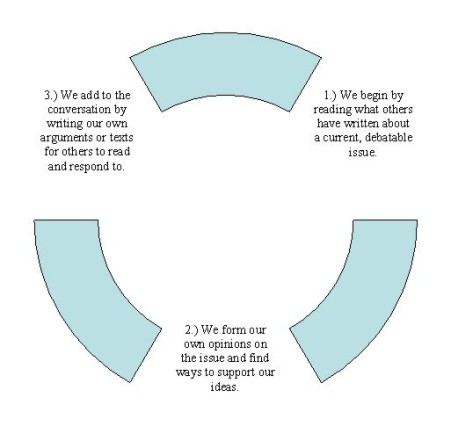Day 2 (Wednesday, August 26)
Lesson Objectives
Students will
Prep
Before today's class, review notes on examples and images of green rhetoric. Be sure you have familiarized yourself with how “green” is being rhetorically constructed. Be sure you have reviewed the rhetorical triangle for today. Write out your lesson plan.
Materials
Overhead Transparencies:
Lead-In
For today's class, students have prepared brief definitions for “green” and “rhetoric,” and collected their thoughts on the rhetoric of green. It’s not uncommon to have a few students come to class the second day without having done the homework, or for new students to show up. Unprepared students will be able to join in a group without too much floundering. Arrange a way to help students with any problems (couldn’t log on to Writing Studio, bought the wrong textbook, etc.), but plan on a Write- to-Learn (WTL) or other means of holding students accountable for the reading assignments in the future. Remind students of the upcoming limited add/drop policy deadlines. Refer them to the yellow sheet you handed out on the first day.
Activities
If you arrive to class a few minutes early, you might write the "agenda" on the board. A brief list of today's activities could go something like:
If you choose to put up an agenda, make it a reliable routine.
Attendance (2-3 minutes)
Take care of any remaining registration issues (such as new students or students that were absent on the first day), and be sure to note which students are absent. You might take attendance by asking each student to describe one thing he or she remembers about a classmate from the getting-to-know-you activity last time. Or, you can collect the homework as a means of taking attendance. Be sure to tell students you are taking attendance this way, if you choose to do so.
Group Writing Activity (10 minutes)
Put the following steps on an overhead:
Conduct a class discussion. Discuss the definitions of “green” and “rhetoric” followed by Rhetoric of Green examples (15-20 minutes)
Reiterate the idea of writing as conversation (3-5 minutes)
Return to the overhead from the first day.
The following is a visual representation of the way in which this course is designed around the writing as conversation metaphor. Before explaining, present it to students on an overhead.

Once the students can see the image, explain:
Right now, we are at the first stage: reading what others have written. That is, we are listening in on the conversation. Later in the semester, we will conduct research to form our own opinions and add to the conversation.
An important part of academic inquiry is being able to set aside one’s own biases and preconceived ideas and really listen to what others are saying about the issue. This isn’t to say that readers don’t have reactions and responses but that it’s essential to be able to distinguish between subjective reactions to what the writer has said and an objective understanding of what the writer has said.
Stress the importance of remaining open-minded as we look at parts of the conversation going on about “green.” At this point in our inquiry, we are most concerned with the writer’s purpose, audience and context of what is being said, and less concerned with agreeing/disagreeing with the content of the essays.
Discuss Thesis Statements and Main Points (5-10 minutes)
Take time to define "thesis statement." There are many ways of defining this term; for our purposes a definition such as "the overall idea that the writer wants to communicate to readers" works well. You might ask students what other words they’ve associated with “thesis,” such as “central claim,” “primary argument,” etc.
How can a reader find a thesis statement? Brainstorm ideas.
Take time to define “Main Point” and how it is different from the thesis.
Activity: Continuing the class discussion, provide a summary outline of the Rhetoric of Green Reader Preface in a chronological fashion.
Summary: The stuff you’ll need to identify
a. What is the authors’ main argument?
a. What reasons do the authors give to support the thesis?
Assign Homework for Friday (3-5 minutes)
Conclude class
Conclude class by saying something like, next time we will continue our exploration into the conversation about green rhetoric by looking closely at a text and being able to summarize the content and analyze the rhetorical situation.
Connection to Next Class
Take time to read over today's homework to assess students' prior knowledge of and opinions about the topic, to casually assess their writing abilities, and to add to the list of terms and questions for discussion and further inquiry.
On Friday, you will continue on with concepts you introduced today. You’ll move from identifying an author’s thesis to identifying and summarizing the argument as well as analyzing it in a rhetorical context.